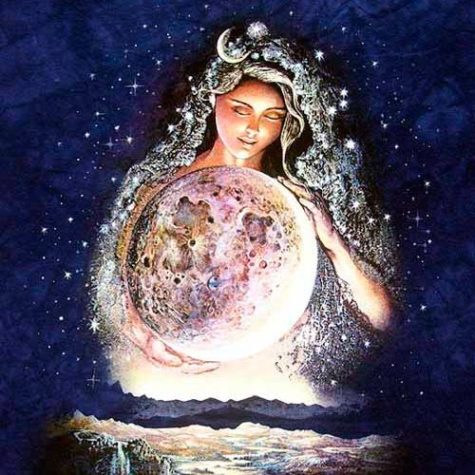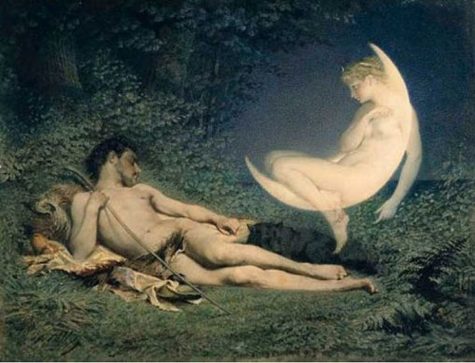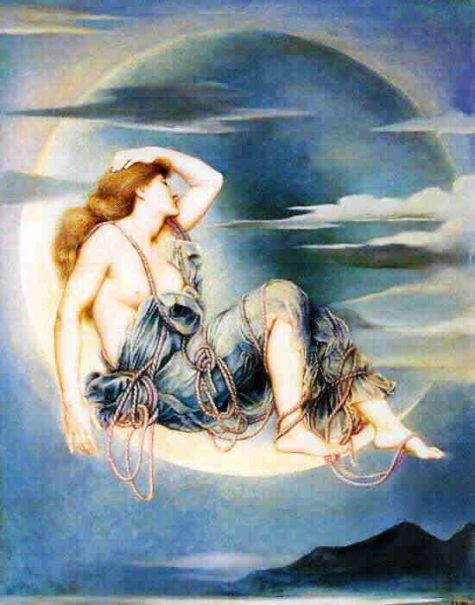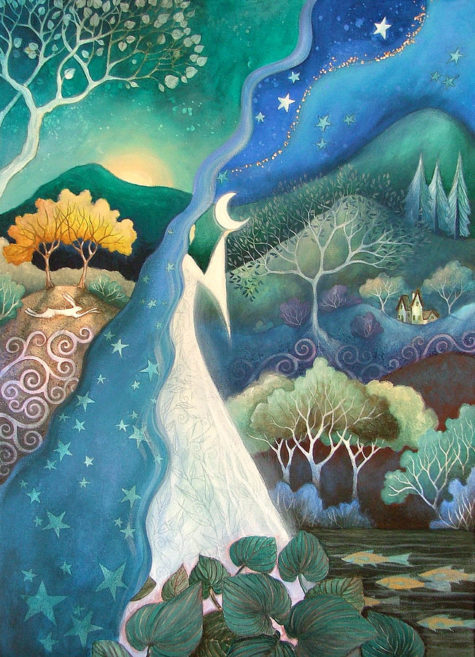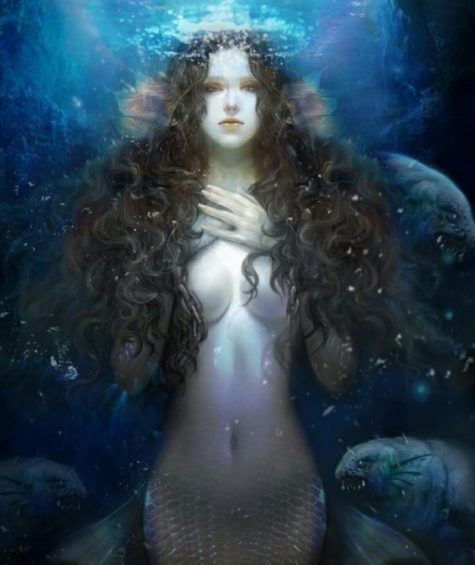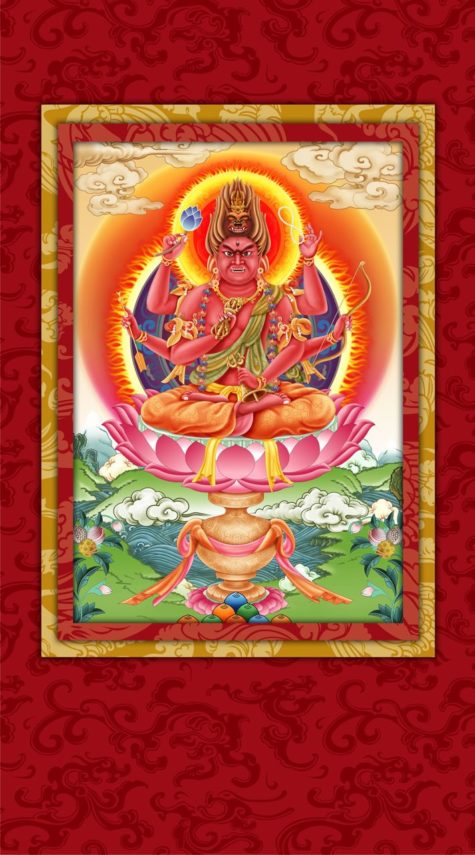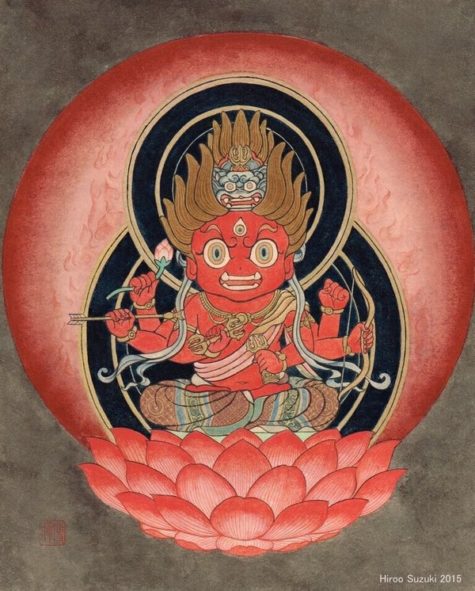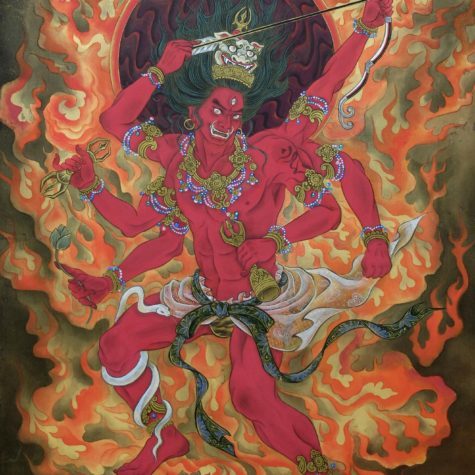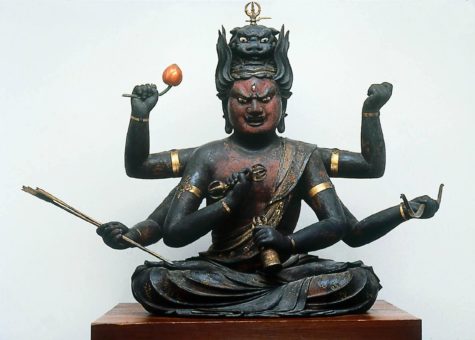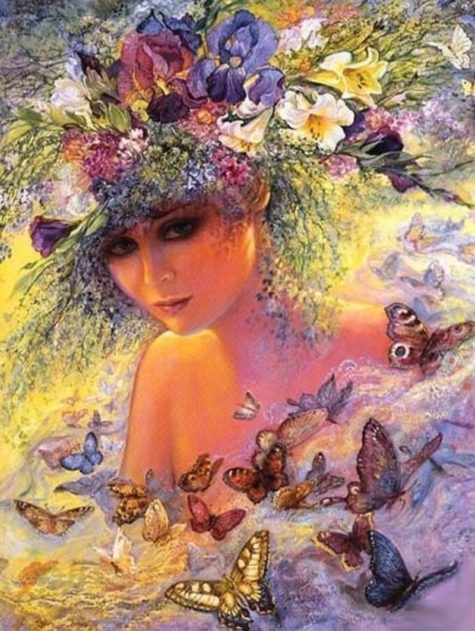Love
- Also known as: Mene (as in month or menstruation), and Latin Luna
- Origin: Greece
- Stones: Moonstones and Selenite (literally “moon rock”)
- Favored people: She is the matron of magicians, sorcerers, witches, and moon-gazers.
Selene is an ancient goddess of the moon. Comparatively little information regarding Selene’s veneration and rituals survives although she is described as “great in magic” and was apparently invoked in magic spells. Her parents are Titans, Hyperion and Theia. Helios, the sun, is her brother. Many of her functions were later transferred to Artemis as Helios’ were to Apollo.
Selene bathes in the ocean before riding up to the sky in her chariot every night, variously driven by a pair of white horses, bulls, or mules. She pulls the full moon across the sky. Alternatively she rides a horse sidesaddle. Sometimes Selene has to hide from a dragon, indicated by a lunar eclipse or absent moon. Or perhaps Selene is just making time with that dragon. Selene is an amorous goddess with many lovers including Pan and Zeus, with whom she had numerous children.
Her most famous love affair is with the young shepherd Endymion, the male sleeping beauty. Selene placed him under an eternal sleep spell so that his entire existence consisted of sleeping and making love to her. Selene spends her days in the Anatolian cave in which Endymion sleeps.
Selene’s name is etymologically related to a word meaning “light.” In her guise as the full moon, Selene sheds light on problems and mysteries.
- Manifestation:
Selene is the goddess of the moon, but she also is the moon. Selene may manifest as a woman or a cow, but you can also gaze at the moon and see her. As a woman, she is described as being very beautiful. She has wings and wears a diadem.
A scholarly article about the Goddess Selene:
Also called Mene, or Latin Luna, Selene was the goddess of the moon, or the moon personified into a divine being. She is called a daughter of Hyperion and Theia, and accordingly a sister of Helios and Eos; but others speak of her as a daughter of Hyperion by Euryphaessa, or of Pallas, or of Zeus and Latona, or lastly of Helios. She is also called Phoebe, as the sister of Phoebus, the god of the sun.
By Endymion, whom she loved, and whom she sent to sleep in order to kiss him, she became the mother of fifty daughters; by Zeus she became the mother of Pandeia, Ersa, and Nemea . Pan also is said to have had connection with her in the shape of a white ram.
Selene is described as a very beautiful goddess, with long wings and a golden diadem, and Aeschylus calls her the eye of night. She rode, like her brother Helios, across the heavens in a chariot drawn by two white horses, cows, or mules. She was represented on the pedestal of the throne of Zeus at Olympia, riding on a horse or a mule; and at Elis there was a statue of her with two horns.
In later times Selene was identified with Artemis, and the worship of the two became amalgamated. In works of art, however, the two divinities are usually distinguished; the face of Selene being more full and round, her figure less tall, and always clothed in a long robe; her veil forms an arch above her head, and above it there is the crescent. At Rome Luna had a temple on the Aventine.
Ritual to Selene
- Color: White and silver
- Element: Water
Altar: Lay with a white cloth, on which is sewn moons of silver in cycle from new to dark. Set out two white candles rubbed with jasmine oil, a silver tray with round white cakes, a glass pitcher of goat’s milk, a glass chalice of white wine, a glass of clear anise liqueur, a round mirror, and a silver bell.
Offerings: White foods. Milk, poured in libation. A promise to aid those suffering from mental illness or emotional confusion.
Daily Meal: Nothing but milk or rice milk to drink. Rice. Custard. Cream soups and sauces.
Invocation to Selene
Lady of the Full Moon
White Lady whose rays shine on us
Lighting our path through the darkness
Round as a full belly
Pregnant with possibilities,
White as mother’s milk
And snow on high mountaintops,
Moon mother who sings to us
Lullabies of imagination,
Cascade through our dreams,
Sail us through the ebb and flow
Of our heart’s tides,
And light our spirits
With your serene love.
Chant: Luna Lucina Lumen Lumen
The cakes are passed around, saying, “Eat of the Mother’s sweetness.” Then the pitcher of milk is passed around, saying, “Drink of the Mother’s love.” Then the chalice of wine is passed around, saying, “Drink of the Mother’s dreams.” Then the glass of liqueur is passed around, saying, “Drink of the Mother’s song.” Then the remainder are poured out as libations and the silver bell is rung six times.
Sources:
- Alternative names : JURATA, JŪRATĖ, JURASMAT
- Location : Lithuania, Latvia and Prussia
- Gender : Female
We connect with the Goddess Jurate to promote feelings of courage and unforeseen love. Her sway of the sea flows directing into our afflictions, washing away the fear and doubt, and rolling in the acceptance of the journey of love. There are times in life when we feel we do not have the strength or motivation to pursue the completion of our set goals of compassion and love. We must follow through, with pride and determination for the journey ahead.
We must never be driven away from our path, by unsettling feelings of fear or self-doubt. We should embrace the adventure of love, for it is a roller coaster that is the act of life personified.
Lithuanian Myth of Lost Love
A famous folktale favorite across the Baltic and beyond, Jurate is Queen of the Lithuanian mermaids — a rare and unusual mythological species. She is also a deity of healing who fell in love with a mortal called Kastysis.
At the deepest point of the Baltic Sea, a beautiful, goddess (sometimes described as a mermaid or undine) Jurate lived in a beautiful and unusually fascinating castle made completely from the shiny golden amber. While on the shores of the Baltic Sea (in Šventoji town to the north of Palanga), not far from the castle of the goddess, a young and handsome fisherman named Kastitys lived in the poor shack and earned for living with fishing.
Jurate ruled the sea and all of the sea-life. Each and every sea creature was not simply the subject to her, but a true lovely friend. Jurate knew that people were killing them for survival and although it destroyed her from the inside, there was nothing that could be done. A lot of people were dealing in the sea, relying on and surviving only due Jurate’s kindness, but one of them was known for being extremely active. A young fisherman named Kastitys was continuously disturbing the peace in her kingdom by catching daring amounts of fish. One day, Kastitys had not succeeded in his usual area and swam too near the castle of the beautiful goddess, despite the existing restrictions that his people respected for centuries.
The anger of Jurate knew no boundaries. This reckless fisherman must be stopped. Jurate sent mermaids to the fisherman with a warning stay away from her castle and to stop killing her fish friends. But this had no effect. Kastitys was desperate and daring – he ignored the warnings of the mermaids.
Even though she was angry, Jurate became extremely curious about this simple mortal who was not even slightly afraid of the anger of the gods. She decided that she wanted to see this person who was so fearless, and so she swam to the surface of the sea.
When Jurate saw the beautiful Kastitys, and heard the glorious songs he sang to entertain himself while fishing, she was completely won over, and fell desperately in love. Listening with delight to the songs, Jurate quite forgot that immortal gods were not allowed to enjoy fleeting human happiness. She completely forgot about everything that had once been important to her.
Jurate took Kastitys to her beautiful amber castle, and they spent days and nights enjoying each others company and their love, totally losing track of time. Unfortunately, their happiness didn’t last.
Perkunas, Baltic god of thunder, rain, mountains, oak trees and the sky was furious when he learned that the goddess had allowed herself a terrible liberty. To be involved in relationship with a mere mortal was unforgivable. Perkunas, was in love with Jurate. However Jurate did not return the feeling and was not interested in the thunder god in any way. She had rejected and spurned his love many times. Not only had she fallen in love with another man, but she had fallen in love with a mortal man!
He sent a bolt of lightning to destroy the goddess’ palace and kill her mortal lover. According to eyewitness reports, the amber palace was smashed into little bits and Kastysis smashed with it. Her healing efforts were in vain and he died.
Perkunas chained Jurate with gold chains to the ruins of the underwater palace. That was the high price that she had to pay for her short happiness.
She weeps tears of amber for her lost lover. When the storms stir the sea, fragments of her palace ruins are driven onto the shores of the Baltic. Tear drop shaped pieces are thought to be particular treasures as they are the tears washed from the grieving goddess’ eyes. These amber pieces are said to be as clear and true as her tragic love.
Years and centuries pass, but the immortal Goddess is still suffering. Day by day, looking at the lifeless body of her beloved, enmeshed in heavy golden chains, she is shedding bitter tears. The cold sea depths are beginning to sway from her inconsolable sobbing. A storm is rising. The storming sea is rolling its waves towards the shore throwing onto the sand splinters of the amber castle and small hardened drops – Jurate’s tears.
Jurate put everything on the line being with Kastytis, and lost, but she would do it again in a heartbeat because love is the only catalyst to pure happiness, that cannot be replicated or changed into anything else.
Embracing our deep connection to the goddess Jurate can help us find the bravery to take the ultimate risk to be in love. She is not commonly known as a goddess of love, but her story compares to that of no other. To honor her love, and incite feelings of bravery, utilization of an Amber crystal is best. Carry her legacy with you to inspire yourself to go against any odds in life to find your love.
Her strength is a type of bravery that often goes unnoticed; the willingness and courage to change your life into one of completely new templates. When you are in love, you suddenly feel that you can and will do anything and everything for that one special person. You put your entire life in their hands, and forget the vulnerability and openness of entrusting another human being with the baggage that is you. Commitment is often difficult, because sometimes you start off with nothing to lose, and end up losing everything. You put all your apples in one basket that you lose sight of the path in which the basket will travel; if it will be clear, or riddled with obstacles.
Love is a path often untraveled by man, as the journey is difficult and sometimes confusing. We must embrace our inner light of love and divinity. Embrace your goddess today, and promote love to everyone around you. Feel the love inside of you, and spread it to others.
Aizen-Myōō, also known as Rāgarāja, is one of the five Wisdom Kings. Other titles and names include the following:
- Lord of Passion
- King of Lust
- Lust-Drenched One
- Impassioned One
- King of Sexual Passion
Ragaraja, Buddhist Lord of Passion, traveled from India to Japan, where he transformed into Aizen Myo’o, venerated by Japan’s esoteric Buddhist sects as King of Love, Lust, and Desire, patron of erotic love and sacred sexuality. He helps convert earthly, physical desires into transcendent love and spiritual awakening.
He is portrayed as a red-skinned man with a fearsome appearance, a vertical third eye and flaming wild hair that represents rage, lust and passion. Also the Lustful-Tinted Wisdom King was popular among Chinese tradesmen who worked in the fabric-dying craft, typically accomplished with sorghum.
He is still venerated as a patron of landlords, prostitutes, homosexuals and petitioned by devotees for a peaceful home and abundant fortune in business. There is usually a lion’s head on top of his head in his hair, representing the mouth into which thoughts and wishes may be fed. Some of these are the wishes of local devotees who make formal requests for success in marriage and sexual relations.
Aizen Myo’o is King of Lust because he helps control it, explore it, or transform it into enlightenment. He is petitioned for assistance with the physical and emotional frustrations of suppressed sexuality. Aizen Myo’o is revered as patron of gay love, but he may be invoked for assistance with any kind of love or romance, including self love.
Aizen converts earthly desires (love/lust) into spiritual awakening, and saves people from the pain that comes with love. Aizen is celebrated in Japanese rites to achieve harmony and friendship, to succeed in one’s romantic endeavors, to gain the love and respect of others, and to reach a clear understanding of the Dharma (Buddhist law).
- Favored People:
Aizen Myo’o guards prostitutes and sex workers. He is venerated by those for whom sex is a business, including sex shop owners and those working with any form of pornography or erotica. He is also venerated by singers, musicians and landlords.
He is the patron deity of dyers, possibly because the second part of his name means “dye” or “to dye” (hence “soaked”).
Today, Aizen is revered in Japan’s gay quarters as the patron of love. Aizen does not appear in Indian texts, and is unknown among India’s deities.
- Iconography
Aizen is usually depicted with a red body possessing eight arms and three eyes on an angry face. A lion’s head rests in his hair, symbolizing passion. He carries bows and arrows, which symbolize love as well as his role as a destroyer of evil. Aizen’s red body symbolizes the power to purify sexual desire. He is typically bright red, suggesting the force of the passions, yet, at the same time, the vigor of his compassion.
He is portrayed as a red-skinned, frowning man, his appearance representing suppressed lust and passion. He variously has two, four or six arms; in the latter form, his hands bear a bell, a stick, a thunderbolt, a lotus, a bow and an arrow. Similarly, he sometimes has two heads, with a lion’s head in his wild hair.
His lion headdress indicates that Aizen possesses the strength of the five wisdom Buddhas. His three eyes are able to see the “three realms” of desire, form, and non-form.
His mouth is usually half-opened and reveals fangs. His hair is fiery and stands on end. Aizen is often surrounded by flames, which indicate the burning power of the passions. Aizen is usually seated on a lotus throne and carries a lotus flower in one of his four arms.
The most distinctive feature of Aizen is his bow and arrow, which is the best way to identify him (though it is sometimes missing). Interestingly, experts on Buddhist iconography are not agreed about the precise meaning of the bow and arrow.
All agree that it is a weapon against evil. Furthermore, according to some, it chases away carelessness and neglect (in observing Buddhist precepts).
For others, the arrow is Aizen’s love (somewhat like Cupid’s arrow), and, in another theory, it is the conquering strength of wisdom. Sometimes, Aizen holds a small mirror, a symbol of the void in Buddhism. He typically appears with six arms, but sometimes with only four.
The blood-red body and flaming halo of Aizen Myōō, the Wisdom King of Passion, represents the state at which sexual excitement or agitation becomes enlightenment and passionate love becomes compassion for all living things. In Buddhism, he manifests as a vajrasattva.
Aizen Myōō is the embodiment of rage: his hair stands on end, a snarling lion rises from his head, and his six arms brandish Esoteric Buddhist weapons and other emblems of power. The bow and arrow in his middle hands are attributes appropriated from Kama, the Hindu god of love.
Though fearsome in appearance, this wisdom king acts only out of love for others. In Japan, Aizen is thought to control the amorous passions, redirecting them to ward the struggle to overcome desires.
In contrast to this righteous anger, jewels of good fortune forming flaming clusters spill from a vase in front of the deity’s lotus throne. While Aizen Myōō’s appearance may instill fear, the faithful afflicted with problems of the heart address him as a popular intercessor.
The Rāgarāja Mantra
Appropriately, Rāgarāja’s mantras are pronounced in either Chinese or Japanese transliterations of Sanskrit; the cadences depending upon the respective region where his devotees reside and practice, and whether in the Shingon or Tendai schools. His seed vowel, as written in bonji, is pronounced “HUM,” usually with a forceful emphasis coming from the use of lower belly muscles.
To invoke Ragaraja, one needs to form his mudra and chant his mantra. While holding the mudra, rub the middle fingers against each other – this represents ”love to connect.” By invoking him in this way, Ragaraja will come quickly and descend into your body.
Here’s a video:
For the sake of the men and women in emotional distress, sentient beings engaged in love and passion, and couples who are separated and need to patch up their relationships, here is the Sadhana of the Ragaraja Affection Practice:
The practitioner must first enshrine the image of Ragaraja. The practitioner may purchase an image, or find an artist to paint an image of Ragaraja, or get a sculptor of Buddhist statues to carve one.
- The Offering
Find the stamen from a red lotus and remove 108 strands from it as an offering. Also make offerings of other foods with a mix of the five tastes: sweet, bitter, sour, salty and hot.
- Preliminaries
Perform the Fourfold Refuge, the Great Homage, the Great Mandala Offering, and the Four Immeasurables.
- The Mudra
Form the Root Mudra of Ragaraja: The two hands have fingers crossed and inwardly clasped like a vajra fist, except for the middle fingers which stand erect and crossed over each other. Form the mudra first before entering into the visualization.
- Visualization
Visualize Ragaraja descending from the light of the sun. Visualize flames surrounding the body of Ragaraja. Visualize your loved ones appearing within the flames. Visualize the arrow of Ragaraja shooting towards the hearts of the loved ones.
- The Mantra
Recite the mantra of Ragaraja: OM MAHARAGA VAJROSNISA VAJRASATTVA JAH HUM BAN HOH. Recite this mantra 108 times, or 1080 times, counting the recitation with your mala beads.
- The Meditation
Sit in meditation and enter into samadhi. The practitioner visualizes himself entering into the heart of Ragaraja together with his loved ones.
Once he comes out of his meditative absorption, the practitioner dedicates the merits and asks that Ragaraja keep his vows to bring fulfilment to the desired love and relationship.
- Concluding the Practice
After performing the Great Homage, take the 108 strands of the red lotus stamen combined with sandalwood incense powder and burn the mixture before the statue of Ragaraja. When you cultivate this practice, a miracle may happen after only a day.
Some individuals may request a sculptor to carve a small statue of Ragaraja out of white sandalwood, about the length of one`s finger. You may enshrine the statue in your shrine, and bring it along with you when you leave the house.When you practice doing this, you shall find fulfillment in all things, especially earning respect from people.
Important Points
I hope everyone who practices this method will benefit from it. However, remember that this practice is meant for those who are sincere and honest, and will not work for people with ulterior motives.
- If a female who is flirtatious and married desires another male, this practice will never work.
- If a male who craves the opposite sex desires another lady when he already is married, this practice will never work.
- If a prostitute with ill intentions desires to catch a rich man, this practice will never work.
- If a male whose heart is fickle and whose actions are topsy-turvy, speaks of love but actually desires sex, this practice will never work.
Here is a verse:
Supreme as Ragaraja himself,
Whose merits and vows are kept firmly in his heart,
When you are sincere and your love is strong as gold and rock,
Pray to him and receive his pure light
Which quickly transforms a relationship to one of affection.
As the self-nature is dissolved into the realm of affectionate beings,
All hindrances shall be eliminated,
Closing the gap between those truly in love
Other Mantra Practices
Ragaraja is a great and mighty deity of love and respect. If relations between a couple are not harmonious, if one wants to acquire great love and admiration from male and female friends, if one wishes to become president or an artist, if one wishes to have a great affinity with all people, if one wishes the presence of valuable people, if practitioners need companions for success on the path of cultivation or need help from someone, if one needs the help of others in one’s studies, if farmers need workers to work for them, and if businessmen need nonstop benefits, they should all practice Ragaraja.
- Assisting in Attaining Spiritual Union with the Principal Deity Dharma
While practicing Vajrayana Buddhism, even after you recite mantras and practice many dharmas, you may still not have any spiritual response from any deity. By reciting Ragaraja’s mantra 300,000 times one will quickly achieve spiritual response.
Ragaraja has great dhama power. One can readily receive spiritual union with one’s personal deity while praying to him for it. Therefore, everyone should chant the deity’s mantra, because he belongs to ”love to connect.”
One will rapidly achieve spiritual union if one practices one’s personal deity after having recited Ragaraja’s mantra for 300,000 times! This is because he is ”love to connect,” which means to ”get you connected.”
- Dharma for Annihilation of Evil
Paint or draw Ragaraja’s image then hang the image on the west wall so that Ragaraja’s image faces east. Then, after completing 300,000 recitations of the Ragaraja mantra, you can perform the ”Shooting with Ragaraja’s Bow and Arrow Dharma.”
Facing to the front, visualize the person you consider to be your enemy in front of you and yourself holding a bow in one hand and an arrow in the other. Then shoot the arrow at the visualized person. The person will no longer go against you.
A second method is as follows. One chooses the afternoon of a ”Chu” (”Removal”) day to practice the dharma. Standing in front of Ragaraja’s image face to the east and form a gesture as if shooting an arrow while you recite the Ragaraja Mantra 108 times. Then, visualizing your enemy in front of you, shoot the arrow at him. Your enemy will immediately retreat.
- Dharma of Drawing an Image
Vajrayana Buddhism highly regards painting a Buddha’s image. While you are painting the Buddha’s image, your entire mind is so focused that you will paint continuously. Because of this attentiveness, the divine nature of Ragaraja will enter the painting you have drawn, and the painting will already be powerful when you hang it up.
When practicing Image Drawing Dharma, one will obtain spiritual union quickly and easily because after drawing Ragaraja’s image for so long, Ragaraja is imprinted in one’s mind.
- Dharma of Love and Respect
Homa for love and respect must be performed between the 16th and 30th days of the lunar calendar. Set up the fire offering mandala in the form of a lotus shaped semi-circle. All offerings, such as flowers, fruits, food, drinks, clothing or other items must be red in color. Throw 180 red lotus stamens into the homa fire burner to be burned. When reciting the mantra, chant ”hum tsa-zhi-hum re” Command ‘name of the person’ and ‘name of the person’ to love and respect each other.”
Please remember, this is to be practiced by one who is honest and sincere. It is not meant to be practiced by ”one who has evil intentions.”
- Nectar Dharma
Ragaraja sits on top of a nectar vase. A lotus stems grows out of this nectar vase becoming a thousand petaled lotus. Visualize that Ragaraja transforms on top of this thousand-petaled lotus, Rajaraja is transformed from the syllable ”hum” The lotus is transformed from the syllable ”bang.” The nectar vase is transformed from the syllable ”seh.” Visualize Ragaraja moving to the top of your head. Ragaraja’s nectar vase is dripping nectar which enters your central channel. Visualize your whole body filled with nectar that eliminates all your bad karma.
You can visualize the amrita as red because Ragaraja is red in color. At this time, your whole body is filled with red amrita and you are purified. This way, you can easily go to Buddha’s Pure Land.
- Carved Image Dharma
Have someone carve an image of Ragaraja about the height of your right thumb. Ragaraja’s height, width, and length should be exactly the same size as your thumb. Because you desire Ragaraja to be fully engraved in your heart, when you have completed 300,000 mantra recitations, Ragaraja will then have a spiritual union with you. Wherever you go, everyone will respect you and all their love will be reflected on your body.
One should practice Carved Image Dharma to protect oneself from being harmed by witchcraft, black magic spells, or evil practices. What one needs to do is to carve the image of Ragaraja and wear it as a pendant in front of one’s chest.
While wearing the carved image of Ragaraja, if you fall in love with a person and wish for Ragaraja to help reciprocate love from this person, all you need to do is recite the Ragaraja Mantra 7 times, and say the person’s name. Alternatively, say ”command ‘names of the person’ and ‘name of the person’ shall love each other.”
Also, after completing 300,000 recitations of Ragaraja Mantra, carry the carved image of Ragaraja with you. Recite the mantra 7 times while on the plane; 7 times while on the boat; 7 times while on the train; or 7 times while in the car. Whichever transportation you take, or if you are walking, or anywhere you may be, recite 7 times; you will not encounter any disasters or calamities.
- Dharma of Exorcising Demons
When helping a mentally ill patient or a person possessed by evil spirits, visualize yourself transforming into Vajrasattva. Then visualize that the syllable ”hum” on the palms of both hands transform into Ragaraja. On top of your head, the ”hum” syllable transforms into Ragaraja; on your face, the ”hum” syllable transforms into Ragaraja. Transform your ”Vajrasattva” body into ”Ragaraja’s” body. Pat the back of the mentally ill patient or person that has been possessed by evil. Or recite ”hum tsa-zhi-hum re” and pat the patient’s back with both your palms. The evil spirit possessing the body will then naturally leave.
- Dharma of Detoxification (Dharma of Purification)
All you have to do is recite the Ragaraja mantra 300,000 times. Then, for any food that you eat, first recite ”hum tsa-zhi-hum re” 7 times. After eating this food, even if it was spoiled or contaminated, the food will become fresh and clean again. When you go home, you will not have diarrhea.
Someone may put a curse on you with black magic, or put a curse on your food, or lace your food with sedatives or other mind-altering drugs. All you need to do is face toward the soda or food and recite ‘ ”hum tsa-zhi-hum re ‘ 7 times and the drugs or sedatives will no longer be effective. Anything that is contaminated will lose its effectiveness and be purified. Anything that is bad will become normal. Anything that has been poisoned will be detoxified.
Therefore, if one falls under spells of black magic or is harmed by witchcraft such as that practiced in Sichuan, Yunnan, Guangxi, and Xiangxi, the witchcraft and the black magic spells can be undone as long as one practices this dharma.
Even if you find yourself in hell and see poisonous snakes, just recite ”hum tsa-zhi-hum re” 7 times and the poisonous snakes will leave. If you are in the hell of swallowing red hot molten metal balls, all you need to do is recite the Ragaraja Mantra 7 times ”hum tsa-zhi-hum re” and the metal balls will turn into moon cake. When you are in the hell of filthy excrement recite ”hum tsa-zhi-hum re” 7 times and all the feces will turn into sausage. Any bad thing will transform into something good.
Information collected from a variety of sources.
Flora is the Roman Goddess of flowering plants, especially those that bear fruit. Spring, of course, is Her season, and She has elements of a Love-Goddess, with its attendant attributes of fertility, sex, and blossoming. She is quite ancient; the Sabines are said to have named a month for Her (which corresponds to our and the Roman April), and She was known among the Samnites as well as the Oscans, where She was called Flusia.
She was originally the Goddess specifically of the flowering crops, such as the grain or fruit-trees, and Her function was to make the grain, vegetables and trees bloom so that autumn’s harvest would be good. She was invoked to avert rust, a nasty fungal disease of plants that causes orange growths the exact color of rusting iron, and which was (is) an especial problem affecting wheat.
Hers is the beginning of the process that finds its completion with Pomona, the Goddess of Fruit and the Harvest; and like Pomona, Flora had Her own flamen, one of a small number of priests each in service to a specific Deity. The flamens were said to have been instituted by Numa, the legendary second King of Rome who succeeded Romulus; and whether Numa really existed or not, the flamens were undoubtedly of ancient origin, as were the Deities they served.
In later times Flora became the Goddess of all flowering plants, including the ornamental varieties. Her name is related to Latin floris, meaning naturally enough “a flower”, with the additional meaning of “[something] in its prime”; other related words have meanings like “prospering”, “flourishing”, “abounding”, and “fresh or blooming”.
In one story, Flora was said to have provided Juno with a magic flower that would allow Her to conceive with no help from a man; from this virgin-birth Mars was born. A late tale calls Flora a courtesan and gives Her a story similar to Acca Larentia: Flora was said to have made a fortune as a courtesan, which She bequeathed to Rome upon Her death, and for which She was honored with the festival of the Floralia. As Flora was originally a Sabine Goddess, and as the Sabines were a neighboring tribe whom the Romans conquered and assimilated into Rome, perhaps this is an acknowledgement of the land so acquired, put into legendary terms.
Flora had two temples in Rome, one near the Circus Maximus, the great “stadium” of Rome where chariot races were held, and another on the slopes of the Quirinal Hill. The temple on the Quirinal was most likely built on the site of an earlier altar to Her said to have been dedicated by Titus Tatius, King of the Sabines, who ruled alongside Romulus for a time in the very early (hence legendary) days of Rome. Her other temple was built quite near to the Circus Maximus, though its exact site has not been found, and was associated with a neighboring temple dedicated to the triad of Ceres (the Grain Goddess) and Liber and Libera (God and Goddess of the Vine). These Deities and Flora were all concerned with the fertility and health of the crops.
Flora’s temple by the Circus was dedicated on the 28th of April in 241 (or 248) BCE in response to a great drought at the command of the Sybilline books, and this day became the starting date of Her great festival, the Floralia. In Imperial times (1st century CE) this temple was rededicated (I assume after some restorations were made) on the 13th of August, and this date was given to a second festival of Flora, coinciding with the ripening of the grain, whose flowers She had set forth.
The Floralia of April was originally a moveable feast to coincide with the blossoming of the plants, later becoming fixed with the dedication of Her temple on the 28th (or 27th, before the calendar was reformed–I mention this because holidays were almost always held on odd-numbered days as it was considered unlucky to start a festival on an even-numbered day), though ludi or “games”–horse-races or athletic contests–were not held every year.
By the Empire the festival had grown (or should I say, blossomed) to seven days, and included chariot-races and theatrical performances, some of which were notoriously bawdy. It was given over to merriment and celebrations of an amorous nature, much like that northern flower-and-sex festival Beltaine whose date neatly coincides. Prostitutes considered it their own special time, and the Floralia gained a reputation as being more licentious and abandoned than the Saturnalia of December, whose name is legendary even now.
At the chariot-races and circus games of the Floralia it was traditional to let goats and hares loose, and lupines, bean-flowers and vetch (all of which have similarly-shaped blossoms and are a sort of showier version of wheat in bloom) were scattered, symbolic of fertility. Brightly colored clothes were a must, as were wreaths of flowers, especially roses; and the celebrations drew great crowds. Of the two nationalized chariot-teams who shared a deep rivalry, the Greens and the Blues, the Greens (of course) were Hers, and She had been invoked at chariot-races from ancient times.
The last day of the festival, May 3rd, was called Florae; it may be a special name for the closing day of the Floralia, or it may refer to a seperate ceremony conducted in Her temple on the Quirinal.
Flora was depicted by the Romans wearing light spring clothing, holding small bouquets of flowers, sometimes crowned with blossoms. Honey, made from flowers, is one of Her gifts, and Her name is said to be one of the secret (holy) names of Rome. She is sometimes called the handmaiden of Ceres. Ovid identifies Her with the Greek flower-nymph Chloris, whose name means “yellow or pale green”, the color of Spring. The word flora is still used as a general name for the plants of a region.
Alternate names/epithets: Flora Rustica, “Flora the Countrywoman” or “Flora of the Countryside”, and Flora Mater, or “Flora the Mother”, in respect to Her ancient origins. Among the Oscans She was known as Flusia.
Source: Thaliatook.com
